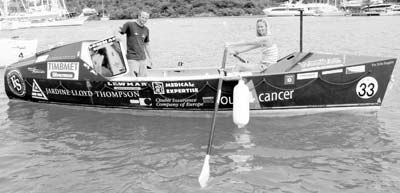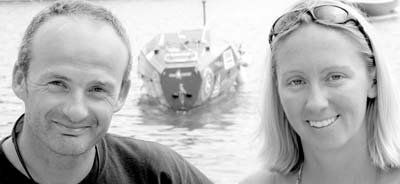Transatlantic the hard way
by Lew Toulmin
Fancy a romantic transatlantic cruise with your sweetheart? How about a nice, relaxing voyage where you row 16 hours a day for 60 days, eat lukewarm freeze-dried food, roll your vessel upside down four times and fend off the amorous advances of a 60-foot whale?
Meet Liz O’Keeffe and Richard Mayon-White, two British adventurers who have done all that and much, much more. I interviewed them at Nelson’s Dockyard in Antigua, West Indies.
Q: Tell me about the voyage.
Richard: Just a few days ago, on January 30th, 2006, we completed our 2,900-mile row across the Atlantic, as part of the Atlantic Rowing Race. We are the first mixed-pair team to finish here in Antigua. This type of racing began in 1995 and is now very popular.
Liz: The race included 26 teams who set off on the 30th of November 2005 from Gomera in the Canary Islands. Most teams were pairs, but there were four vessels with four persons aboard, and two solo rowers. Our team is named Row4Cancer, and we have raised over £40,000 ($75,000) for cancer relief. We often use the boat to carry cancer sufferers, especially kids, for short races to take their minds off their troubles. They love it.
Q: Tell me about your boat.
Liz: Our boat is named Bilbo Baggins, after the Hobbit character and after our wonderful black Labrador who, sadly, had to be put down and is buried near where we kept the boat.
Richard: The race requires all boats to be of a standard size: 24 feet long, with a 9-millimeter-thick (less than ½-inch) plywood hull. There is no real competition regarding external boat design, but each team can design their vessel’s interior. We bought a used boat, gutted it and rebuilt every single system — electrical, navigation, steering, rowing, communications, water-making, cooking, etc. It took three years and required a budget of £60,000 ($113,000).
Q: How old are you, where are you from and what is your profession?
Liz: I am 29, from Poole in the U.K. but born in Holland, and I work in insurance sales.
Richard: I am 39, from Oxford, and am a consultant in leadership and personal development. We live in Southampton now.
Q: How did you prepare for the race?
Richard: We both compete regularly in triathlons, Ironmans and marathons. We both have our Royal Yachting Association Yachtmaster Offshore and other RYA qualifications and have both taught sailing. I climbed Kilimanjaro and Mt. Aconcagua (the highest mountain in South America) and other peaks. I sailed in the famous Fastnet yacht race, and we did lots of weight training, rowing in the gym and rowing the boat when it was ready.
Liz: I competed at the national level in sailing, netball, trampoline, tennis, triathlons and rugby. Before the start, we both bulked up, which was a good thing, since we both lost over 24 pounds during the race. While racing, we ate mostly freeze-dried food, which we boiled in the bag.
Richard: We figure that two-thirds of this kind of race is in the preparation, and if you get to the start line, the chances are good that you will finish.
Q: Tell me about your whales.
Richard: We saw lots of whales and dolphins. One calm day, a 60-foot sei (baleen) whale came up on us. He dwarfed our little 24-foot boat. For 45 minutes he circled our boat, eyeing us.
Liz: He seemed to be kind of lonely. Our boat has gray antifouling paint underneath and our oars look kind of like flippers, so after a while we realized that he thought we were an odd but attractive female!
Richard: Yes, he had a little twinkle in his eye and seemed keen for some joy in life. At one point he got underneath the boat and looked up at us, rather plaintively.
Liz: We tried to gently row away, to give him the message that we weren’t interested, but as soon as we started moving he dashed after us. Finally, he gave up and we crept away.
Richard: Another time we were in a storm surfing some big waves, and we saw a big whale surfing down after us. But we got away from him, too. We never saw any sharks, although two race boats were attacked by sharks.
Q: What sort of other problems did you have?
Richard: Everyone expected that the race would have fairly calm weather, like most years. And we hoped to break the mixed-pair record of 53 days for the crossing. But the 2005-2006 hurricane and storm season lasted so long that everyone had troubles. All the boats were affected by hurricane Epsilon, tropical storm Zeta and other smaller storms. We rolled over four times.
Liz: All the boats are self-righting if the vents and doors are closed. But it is so hot, humid and miserable inside the tiny 6-foot cabin when everything is buttoned up that it is very hard to keep it closed. About 400 miles from the finish we saw one of the two support vessels, which always seemed to bring us bad luck. Right then we surfed down a big wave and broke our rudder. We tried to fix it for a day but rolled again.
Richard: Then we were rolled a third time. Liz was rowing and I was in the cabin.
Liz: A massive wave broke over the boat. I was wrenched out of the rowing seat and thrown overboard. I thought I had broken my leg, but I managed to swim back and get over the gunwale, which luckily was very low because the boat was swamped. I was in agony for about 24 hours, but I rested up and kept going. My leg wasn’t broken after all; it was only a torn muscle.
Richard: Our vent was open and so we got lots of water inside, and of course our gear was a mess. But we bailed her out, kept afloat, immobilized Liz’s leg and managed to fix the rudder after five days of work. At that point we just focused on survival. We never thought we’d make it to Antigua.
Liz: Probably the worst part of the trip was hanging on the sea anchor for days, waiting for the storms to subside. Then the cabin is like being inside a washing machine, it’s so rough. (Liz here means that the boat was tied to the sea anchor, a sort of parachute in the water, which prevents the vessel from drifting downwind during a storm.)
Q: What was your fastest speed?
Richard: We recorded an unbelievable speed of 18.6 knots surfing down some huge waves. The noise and vibration were incredible. Normally, when rowing, we average one or two knots over the ground (distance actually made good), and 70% of that is probably current. We are not allowed to hoist any sails, of course.
Q: After all this, are you still keen on getting married?
Richard: Yes, we were engaged before the race and we are still engaged.
Liz: We know some pairs who went ashore after the race, walked off in opposite directions and never spoke to each other again. But we want to keep having adventures together.
Q: What plans do you have?
Richard: We have a long list of projects. We think this kind of adventure helps define us as people. I want to sail around the world alone. I want to race in the 100-mile portion of the Tour de France that is open to the public, bike in the Race Across America, drive in the Plymouth to Dakar £100 car challenge, climb Mt. Denali (McKinley) in Alaska, sail in the Sydney-Hobart yacht race and participate in the Iditarod sled dog race. (The Plymouth to Dakar Challenge, now renamed the Plymouth-Banjul Challenge, is a humorous but difficult race that spoofs the famous, expensive Paris-to-Dakar car rally. In the Plymouth-Banjul race, the maximum amount that can be spent to purchase each car is 100 British pounds, and the maximum amount allowed for car preparation is £15. See www.plymouth-banjul.co.uk.)
Liz: We are thinking of climbing Mt. Vinson in Antarctica for our honeymoon.
Richard: Yes, we want to have some stories to tell our children and grandchildren.
Toulmin: Somehow, I don’t think that will be a problem.
For more information, visit www.
row4cancer.com. The race organizers, Woodvale Events, are planning the Atlantic Rowing Race in 2007-2008 and the Indian Ocean Rowing Race in 2009, if you want to get started on your preparation. See www.woodvale-events.com for details of these races and other individual adventure projects.
Lew Toulmin is the author of “The Most Traveled Man on Earth” (2006, The Village Press, 13108 Hutchinson Way, Silver Spring, MD 20906. ISBN 0977617505 — 450 pp. $16.95 paperback plus $5 s/h), a collection of travel stories, interviews and musings on history. You can reach Lew by e-mail at lewtoulmin@aol.com.


